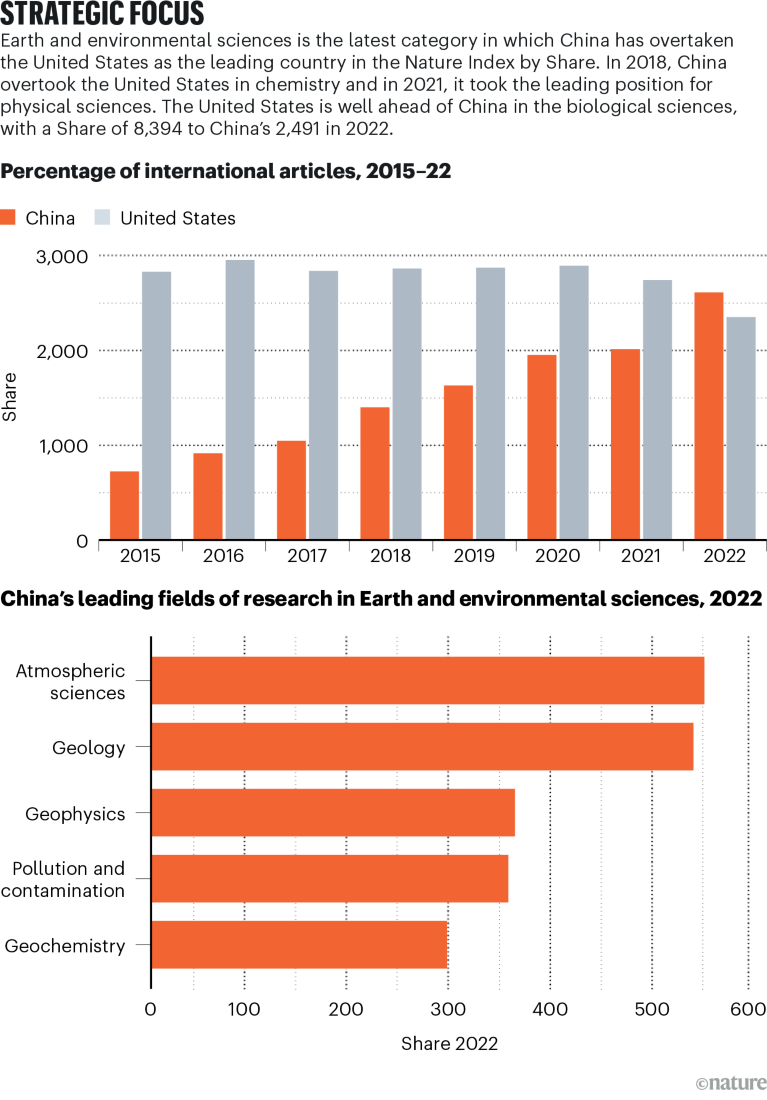What China’s leading position in natural sciences means for global research
09 August 2023
Its rise to the top has been long forecast, but what next for Chinese science in the post-pandemic era?
Chris Woolston
China is pursuing areas of green innovation, such as this smart greenhouse in Yongchuan that automates key processes in rice-plant cultivation.Credit: Si Chuan/Feature China/Future Publishing via Getty Images
Following an
upward trajectory of scientific productivity that has been gathering steam for decades, China has reached a new milestone. In 2022, for the first time, the country
had the highest Share score in the Nature Index for the natural sciences, surpassing the United States.
This has been on the cards since Nature Index was launched in 2014. China’s Share, which measures a country or institution’s contribution to publications in 82 high-quality natural-science journals, has rapidly grown since.
Back in 2015, its
adjusted Share, which takes account of yearly variations in article volume, was 8,430, almost one-third of the United States’ score. But year-on-year rises of between 8% and 21% (apart from 2020, the first year of the pandemic, when growth stalled) have seen it reach the top spot.
This is not the first time that China has been assessed as the leader on measures of scientific productivity. In 2017, it overtook the United States for the total number of scientific publications, according to the US National Science Foundation (NSF). And in 2022, Japan’s National Institute of Science and Technology Policy reported that China had surpassed the United States in a key metric that aims to estimate performance in high-quality science: the contribution to papers that rank in the top 1% most-cited publications.
Such results are significant for Chinese universities and policymakers, says Fei Shu, who studies bibliometrics and researcher assessment at the University of Montreal in Canada and at Hangzhou Dianzi University in China. “China is really rankings driven,” he says.
World-class science
The shift in country rankings in the Nature Index seemed inevitable given the data trend of the past few years, but the achievement is still noteworthy, says Caroline Wagner, a science policy and innovation researcher at Ohio State University in Columbus. “The Chinese have done something truly astonishing” in building a world-class science system in just four and a half decades, she says. China announced its ‘reform and opening-up’ policy in 1978, laying foundations for its higher-education and scientific system.
Hamish Coates, a higher-education researcher at Tsinghua University in Beijing, says the past seven years of China’s journey towards becoming a scientific superpower have highlighted the “strength of its innovation ecosystem”.
China has developed a reputation for relying on imitation to produce such large numbers of papers, says Wagner, but contrary to this common belief, the papers coming out of the country often show high levels of innovation. Wagner co-authored a 2020 study
1 that tracked the percentage of papers that included references to journals in other disciplines, a sign of more creative research that is attempting to cross disciplinary boundaries. The analysis found that papers with at least one China-based co-author were more likely than others to stretch these boundaries. “Not only were they doing good quality work, they were also doing novel work,” says Wagner.
Chinese research remains under-valued, says Coates. In Western universities, “there are plenty of people who have had passing or superficial engagements with higher education in China, or Asia more generally, and have yet to grasp the transformations in play”.
Coates’s home institution — which he says benefits from abundant resources, a concentration of talent and encouragement from academic leadership to publish in top academic journals — is one of many Chinese universities driving the surge in publications. The adjusted Share for Tsinghua University increased by 35.5% from 2020 to 2022, putting it in the top 10 rising Chinese institutions in that period. Others saw even bigger gains in adjusted Share. Sun Yat-sen University in Guangzhou, for instance, went up 52.4% and Shandong University in Jinan almost doubled (up 97.8%).
Immense resources, immense effort
A factor in China’s rising research productivity is its universities adopting a working culture similar to Chinese industry, says Miguel Lim, an education and international development researcher at the University of Manchester, UK. “They work very long hours and there’s a pressure to produce and a pressure to succeed,” says Lim. He adds that many researchers elsewhere work extremely hard for long hours, but that approach isn’t as widespread as it is in China.
The resources behind Chinese science are also immense. The NSF reports that China and the United States accounted for roughly half of global research and development investment in 2019, with the United States spending US$656 billion and China’s outlay being worth $526 billion. According to the National Bureau of Statistics of China, its spending on research and development reached 2.4% of its GDP in 2021, an all-time high. By comparison, China invested just 1.2% of its GDP on research and development in 2004.
Source: Nature Index
The United States’ expenditure on research and development in 2020 was equivalent to 3.4% of GDP. Much of that spending goes towards basic science and preliminary research that might or might not lead to new technologies or therapies. Although China still spends less than the United States on research and development, Lim says the money is focused on results. “There’s a whole state approach that is able to identify certain areas of national interest,” he says. “They’ve identified scientific, technological and engineering areas and concentrated their efforts. It’s not necessarily about blue-sky thinking. It’s a problem-solving kind of approach.”
China’s 14th Five-Year Plan, which sets specific development goals for the period 2021–25 and describes the country’s longer-term vision for 2035, puts a strong emphasis on technological innovation, highlighting recent successes in lunar exploration, supercomputing, quantum information and high-speed trains. It also calls for the creation of national laboratories to focus on network communications, modern energy systems, pharmaceuticals, biotechnology and
artificial intelligence (AI), among other fields.
China is already one of the world’s leading research nations in AI. Stanford University’s
Artificial Intelligence Index Report 2023 found that China accounted for nearly 40% of all publications in AI in 2021, far exceeding the United Kingdom and Europe (15%) and the United States (10%). Papers from China accounted for 29% of all AI citations in 2021, which again puts it ahead of the United Kingdom and Europe (21.5%) and the United States (15%). China ranked second to the United States in a 2022 assessment of AI and robotics articles in the Nature Index, but its annual Share rose more than 1,100% between 2015 and 2021, significantly outpacing the United States, United Kingdom, France and Germany.
Environmental research, such as
projects tackling green energy and pollution, have also rapidly progressed in China (see ‘A clearer view of progress’).
A clearer view of progress
Source: Nature Index
China’s shift towards addressing urgent environmental challenges, such as air and water pollution, green-energy transition and biodiversity loss, has been a major win for researchers. In 2022, China surpassed the United States as the
leading nation in the Earth and environmental sciences (E&E) in the Nature Index, owing, in no small part, to the funding and resources the country has poured into fields including the atmospheric sciences, geology and materials science.
Its efforts are paying off. Since China declared a ‘war on pollution’ in 2014, air quality in cities has steadily improved, thanks to restrictions on industrial emissions and other strategies.
Upgrades to coal-fired power plants — retrofitting smokestacks with filters, for example — have had the biggest effect, according to atmospheric scientist Qiang Zhang, from Tsinghua University in Beijing. A 2019 study by Zhang and his colleagues analysed the main drivers of a recent decline in fine particulate matter in China, and is among the top-cited papers with Chinese authors in the Nature Index for that year (
Q. Zhang et al. Proc. Natl Acad. Sci. USA 116, 24463–24469; 2019).
When it comes to China’s dominance in E&E research, increased funding is only part of the story. Greater numbers of Chinese scientists returning from training abroad have bolstered the country. In the Nature Index, China’s percentage increase in E&E between 2015 and 2022 was the highest among its rise in the four natural-sciences subject areas covered by the database. The country’s Share in E&E in 2022 (2,612) was more than six times that of the United Kingdom (393), which is ranked third in the Index in the subject after the United States, whose E&E Share was 2,352.
There’s still a long way to go. Water availability in Beijing is estimated to be ten times lower today than it was in 1949, and air pollution spikes were reported in 13 northern Chinese cities surrounding Beijing in March, highlighting the importance of the country’s continued investment in E&E research.
Bec Crew
Shifting priorities
China’s current lead in some scientific publishing indicators is not guaranteed to continue, however. In February 2020, the Chinese Ministry of Education announced reforms in its researcher-evaluation system that could alter the publishing landscape. According to the new guidelines, researchers would no longer be evaluated for hiring and promotion decisions on the sheer number of papers they had contributed to. Instead, they would be judged on a limited selection of “representative” articles, preferably including papers published in journals with international influence. At least one-third of the representative papers
must be published in Chinese journals. Coates says such policy changes could diminish the incentives for publishing large numbers of papers, potentially slowing the stream of publications from the country.
In a 2022 paper
2, Shu and his co-authors questioned the real-world implications of the publishing reforms. They note that Chinese researchers had been bristling about the pressure and high expectations of the previous evaluation system, but the authors remain sceptical that the new guidelines will truly change the way in which hiring and promotion decisions are made at institutions.
Shu says that academic employment at Chinese universities remains closely tied to publications, putting intense pressure on researchers, despite
China announcing in 2020 that it had banned the practice of scientists being offered cash rewards based on their publishing record. “Salary is based on publications, and you need a strong publication list to be promoted,” he says. Shu notes that many studies have compared the productivity of scholars in China with scholars in the United States or Europe, “but the comparison is unfair because they work in different environments”.
A cause for alarm?
At a time when some politicians in the United States, European Union and elsewhere are sounding alarms about China’s economic, military and industrial might, some may see the country’s ranking in the Nature Index as another cause for consternation. Wagner, who once advised the US government on science policy in her role as deputy to the director of the Science and Technology Policy Institute, a federally funded research and development centre located in Washington DC, says such rankings could add urgency to calls for greater investment in science in the West. As she explains, rankings lend themselves to a “horse race” mentality that disregards the nuances of international research and collaboration. “Legislators who don’t really understand science might say we need to spend more because we’re falling behind,” she says.
But Wagner stresses that China’s rise in scientific publishing shouldn’t cause panic in the West. For one thing, she says, China is still far behind much of the world in terms of scientific infrastructure, complex research networks and social support for innovation. “We would have to say that the United States, for example, is still vastly far ahead of China in terms of deep scientific roots and the ability to soak up new knowledge,” she says.
Any simplistic measure that compares one country to another also misses the bigger picture of interdependency and collaboration in global science, Wagner says. Here, she emphasizes how Chinese researchers are frequent collaborators on international studies. There are signs, though, that such partnerships are becoming less common. As reported in
Nature3, the number of papers with authors from both the United States and China fell for the first time in 2021.
Wagner notes that since 2000, more than 5 million Chinese scholars and students have left China to work and study abroad. However, research conducted for Nature Index in 2021 by League of Scholars, an academic data and recruitment firm in Sydney, Australia, found the proportion of academics at Chinese universities who had arrived from abroad in the previous three years was almost triple the global average, suggesting many Chinese researchers are now returning. There are also indications of a
slowdown in the number of students seeking to move abroad in the first place.
These changing patterns of interdependency may cause a more lasting effect than China reaching parity with the United States, or even overtaking it, on publication metrics. Denis Simon, who studies Chinese science and innovation at the University of North Carolina at Chapel Hill, warns that “the data should give us cause for concern”. “Not that China is catching up”, he says, but that the West might be missing out on “the expertise that could create very positive synergies in terms of addressing the world’s key problems in science and technology. It is the net addition of Chinese brain power to the solution of these problems that offers the world the greater hope.”
Nature 620, S2-S5 (2023)
Its rise to the top has been long forecast, but what next for Chinese science in the post-pandemic era?

www.nature.com


 asia.nikkei.com
asia.nikkei.com









